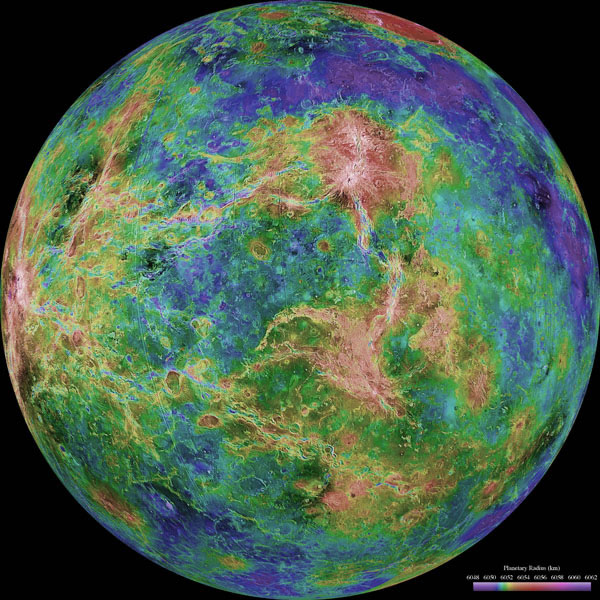Radar Mapping
Radar is used on spacecraft to map the surfaces of other planets. Superb maps of the planet Venus were made with the Magellan spacecraft using radar waves which could penetrate through the dense clouds that completely obscure the surface of Venus.
Radar mapping works by measuring the distance of the spacecraft to the planet’s surface. The distance is less when the satellite is over a mountain than when it is over a valley.
Regular light cameras could not be used to even get a picture of the surface of Venus, much less measure the heights of mountains and valleys.
DIGITAL EFFECT: Radar Mapping
Fade on the orbit of Venus, move Venus to the sweetspot (assumed at 180° azimuth and 45° elevation), and then fly to the daytime side of Venus. Show the radar map of Venus. Still images of Venus and a colorized Magellan radar survey of Venus may also be used in conjunction with this effect.
Optionally, use the still images below, with or without digital effect.
VISUAL 10 (still): Venus with Clouds

DIGITAL EFFECT: Radar Venus
Turn on the radar effect on Venus, showing the Magellan radar mapping data.
VISUAL 11 (still): Radar view of Venus (Magellan Mission) Turn off the radar effect on Venus.

Optional
When radar is used to measure distances to asteroids, the reflected signal is “smeared out” a bit if the asteroid is rotating. There can also be little details of shape in the reflected radar signal that are made by hills, mountains, or craters on the asteroid.
Radar can help us measure distances to objects in our solar system, but our radar is too weak to reach the stars and return. The distances to most astronomical bodies was a great puzzle to people throughout the ages.
Ancient peoples noted that the Moon looked just as far away, and the same size, when they looked at the Moon from a valley as when they looked from the top of a mountain. So the Moon had to be many times farther away than the height of a mountain. But how far? A hundred times? A billion times? Infinitely far away? What about the stars, and the rest of the stuff of the Universe? Are they all infinitely far away? The answers to these questions had to wait for the invention of a new and powerful distance finding technique called parallax.

